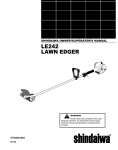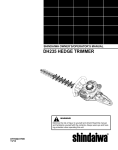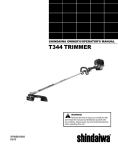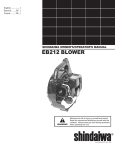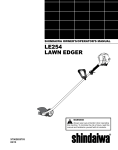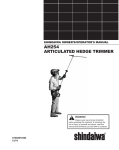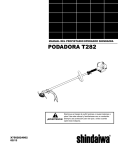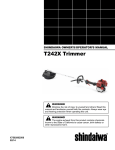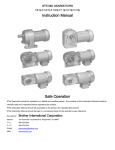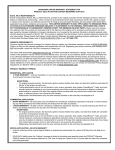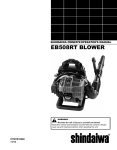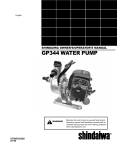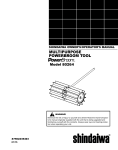Download Shindaiwa EB212 Operator`s manual
Transcript
SHINDAIWA OWNER’S/OPERATOR’S MANUAL EB212 BLOWER Minimize the risk of injury to yourself and others! Read this manual and familiarize yourself with the contents. Always wear eye and hearing WARNING! protection when operating this unit. X7531138401 02/13 2 Introduction The Shindaiwa EB212 Blower is designed and built to deliver superior performance and reliability without compromise to quality, comfort, safety, or durability. Shindaiwa high performance engines represent the leading edge of 2-cycle engine technology, and deliver exceptionally high power at remarkably low displacement and weight. As a professional owner/op-erator, you’ll soon discover why Shindaiwa is simply in a class by itself. the operator’s manual Keep it in a safe place for future reference. Contains specifications and information for safety, operation, maintenance, storage, and assembly specific to this product.. Table of Contents Introduction................................................................. 2 - The Operator's Manual........................................2 Safety..........................................................................3 - Manual Safety Symbols and Important Information..........................................................3 - International Symbols..........................................3 - Personal Condition and Safety Equipment.......... 3 - Equipment Check.................................................6 Emission Control........................................................6 Description..................................................................7 Contents......................................................................8 Assembly....................................................................9 - Blower Application..............................................9 Operation.....................................................................9 - Fuel......................................................................9 - Starting Cold Engine.......................................... 11 - Starting Warm Engine........................................12 - Stopping Engine.................................................12 - Operating Blower...............................................13 Maintenance..............................................................14 - Skill Levels........................................................ 14 - Maintenance Intervals........................................14 - Air Filter............................................................ 15 - Fuel Filter...........................................................15 - Spark Plug..........................................................16 - Cooling System..................................................16 - Exhaust System..................................................17 - Carburetor Adjustment.......................................19 Troubleshooting........................................................20 Storage...................................................................... 21 Specifications............................................................ 22 Warranty Statement...................................................23 Servicing Information...............................................28 - Parts/Serial Number...........................................28 - Service...............................................................28 - Consumer Product Support................................ 28 - Warranty Card....................................................28 - Additional or Replacement Manuals................. 28 Specifications, descriptions and illustrative material in this literature are as accurate as known at the time of publication, but are subject to change without notice. Illustrations may include optional equipment and accessories, and may not include all standard equipment. Power Blower Operator's Manual Safety manual safety symbols and important information Throughout this manual and on the product itself, you will find safety alerts and helpful, informational messages preceded by symbols or key words. The following is an explanation of those symbols and key words and what they mean to you. DANGER The safety alert symbol accompanied by the word “DANGER” calls attention to an act or condition which WILL lead to serious personal injury or death if not avoided. Circle and slash symbol This symbol means the specific action shown is prohibited. Ignoring these prohibitions can result in serious or fatal injury. WARNING The safety alert symbol accompanied by the word “WARNING” calls attention to an act or condition which CAN lead to serious personal injury or death if not avoided. CAUTION The safety alert symbol accompanied by the word “CAUTION” calls attention to an act or condition which may lead to minor or moderate personal injury if not avoided. international symbols Symbol form/shape Symbol description/application Read and understand Operator's Manual. Wear eyes, ears and head protection Hot Surface Safety/Alert DO NOT allow flames or sparks near fuel. Symbol form/shape Symbol description/application NOTE This enclosed message provides tips for use, care and maintenance of the unit. IMPORTANT The enclosed message provides information necessary for the protection of the unit. Symbol description/application Symbol form/shape Emergency stop Fuel and oil mixture Symbol form/shape Symbol description/application Ignition ON/OFF Finger Severing Carburetoradjustment - Low speed mixture Primer bulb Wear hand protection. Use two handed. Carburetor adjustment - Idle speed Carburetor adjustment - High speed mixture Choke Control "Cold Start" Position (Choke Closed) Choke Control "Run" Position (Choke Open) Wear slip resistant foot wear. DO NOT smoke near fuel. Idle Speed Fast Speed personal condition and safety equipment WARNING Users of this product risk injury to themselves and others if the unit is used improperly and/or safety precautions are not followed. Proper clothing and safety gear must be worn when operating unit. 3 4 Physical Condition Your judgment and physical dexterity may not be good: • if you are tired or sick, • if you are taking medication, • if you have taken alcohol or drugs. Operate unit only if you are physically and mentally well. Eye Protection Wear eye protection that meets ANSI Z87.1 or CE requirements whenever you operate the unit. Hand Protection Wear no-slip, heavy-duty work gloves to improve your grip on the blower handle. Gloves also reduce the transmission of machine vibration to your hands. Breathing Protection Wear a facemask to protect against dust. Hearing Protection Proper Clothing Wear snug fitting, durable clothing; • Pants should have long legs, shirts with long sleeves. • DO NOT WEAR SHORTS, • DO NOT WEAR TIES, SCARVES, JEWELRY, or clothing with loose or hanging items that could become entangled in moving parts or surrounding growth.. Wear sturdy work shoes with nonskid soles; • DO NOT WEAR OPEN TOED SHOES, • DO NOT OPERATE UNIT BAREFOOTED. Wear no-slip, heavy duty work gloves. Keep long hair away from engine and air intake. Retain hair with cap or net. Hot Humid Weather Heavy protective clothing can increase operator fatigue which may lead to heat stroke. Schedule heavy work for early morning or late afternoon hours when temperatures are cooler. ECHO recommends wearing hearing protection whenever unit is used. WARNING The ignition components of this machine generate an electromagnetic field during operation which may interfere with some pacemakers. To reduce the risk of serious or fatal injury, persons with pacemakers should consult with their physician and the pacemaker manufacturer before operating this machine. In the absence of such information, ECHO does not recommend the use of ECHO products by anyone who has a pacemaker. Vibration and Cold It is believed that a condition called Raynaud’s Phenomenon, which affects the fingers of certain individuals, may be brought about by exposure to vibration and cold. Exposure to vibration and cold may cause tingling and burning sensations, followed by loss of color and numbness in the fingers. The following precautions are strongly recommended, because the minimum exposure, which might trigger the ailment, is unknown. • Keep your body warm, especially the head, neck, feet, ankles, hands, and wrists. • Maintain good blood circulation by performing vigorous arm exercises during frequent work breaks, and also by not smoking. • Limit the hours of operation. Try to fill each day with jobs where operating the unit or other hand-held power equipment is not required. • If you experience discomfort, redness, and swelling of the fingers followed by whitening and loss of feeling, consult your physician before further exposing yourself to cold and vibration. Power Blower Operator's Manual Repetitive Stress Injuries It is believed that overusing the muscles and tendons of the fingers, hands, arms, and shoulders may cause soreness, swelling, numbness, weakness, and extreme pain in those areas. Certain repetitive hand activities may put you at a high risk for developing a Repetitive Stress Injury (RSI). An extreme RSI condition is Carpal Tunnel Syndrome (CTS), which could occur when your wrist swells and squeezes a vital nerve that runs through the area. Some believe that prolonged exposure to vibration may contribute to CTS. CTS can cause severe pain for months or even years. To reduce the risk of RSI/CTS, do the following: • Avoid using your wrist in a bent, extended, or twisted position. Instead try to maintain a straight wrist position. Also, when grasping, use your whole hand, not just the thumb and index finger. • Take periodic breaks to minimize repetition and rest your hands. • Reduce the speed and force with which you do the repetitive movement. • Do exercises to strengthen the hand and arm muscles. • Immediately stop using all power equipment and consult a doctor if you feel tingling, numbness, or pain in the fingers, hands, wrists, or arms. The sooner RSI/CTS is diagnosed, the more likely permanent nerve and muscle damage can be prevented. DANGER Do not operate this product indoors or in inadequately ventilated areas. Engine exhaust contains poisonous emissions and can cause serious injury or death. Read the Manuals • Provide all users of this equipment with the Operator’s Manual for instructions on Safe Operation. Clear the Work Area • Spectators and fellow workers must be warned, and children and animals prevented from coming nearer than 15 m (50 ft.) while the unit is in use. • Take wind conditions into account: avoid open doors and windows. • Do not point blower at people or animals. • Review area to be cleared. Look for potential hazards such as stones or metal objects. Keep a Firm Grip • Hold the handle in one hand, with thumb and fingers encircling the handle. Keep a Solid Stance • Maintain footing and balance at all times. Do not stand on slippery, uneven or unstable surfaces. Do not work in odd positions or on ladders. Do not over reach. Avoid Hot Surfaces • Keep exhaust area clear of flammable debris. Avoid contact during and immediately after operation. 5 6 equipment check WARNING Use only ECHO approved attachments. Serious injury may result from the use of a non-approved attachment combination. ECHO, INC. will not be responsible for the failure of cutting devices, attachments or accessories which have not been tested and approved by ECHO. Read and comply with all safety instructions listed in this manual. • Check unit for loose/missing nuts, bolts and screws. Tighten and/or replace as needed. • Do not use blower if any part is missing or damaged. • Have repairs done only by an authorized ECHO Service dealer. WARNING Moving parts can amputate fingers or cause severe injuries. Keep hands, clothing and loose objects away from all openings. •ALWAYS stop engine, disconnect spark plug, and make sure all moving parts have come to a complete stop before removing obstructions, clearing debris, or servicing unit. •DO NOT start or operate unit unless all guards and protective covers are properly assembled to unit. •NEVER reach into any opening while the engine is running. Moving parts may not be visible through openings. WARNINg Check fuel system for leaks due to fuel tank damage, especially if the unit is dropped. If damage or leaks are found, do not use unit, otherwise serious personal injury or property damage may occur. Have unit repaired by an authorized servicing dealer before using. Emission Control (exhaust & evaporative) EPA 2010 and Later and/or C.A.R.B. TIER III The emission control system for the engine is EM (engine modification) and, if the second to last character of the Engine Family on the Emission Control Information label (sample below) is “C”, “K”, or “T”, the emission control system is EM and TWC (3-way catalyst). The fuel tank/fuel line emission control system is EVAP (evaporative emissions). Evaporative emissions for California models are only applicable to fuel tanks. An Emission Control Label is located on the unit. (This is an EXAMPLE ONLY; information on label varies by engine FAMILY). PRODUCT EMISSION DURABILITY (EMISSION COMPLIANCE PERIOD) The 50 or 300 hour emission compliance period is the time span selected by the manufacturer certifying the engine emissions output meets applicable emissions regulations, provided that approved maintenance procedures are followed as listed in the Maintenance Section of this manual. Power Blower Operator's Manual Description Locate these safety decals on your unit. Make sure the decals are legible and that you understand and follow the instructions on them. If a decal cannot be read, a new one can be ordered from your Shindaiwa dealer. See PARTS ORDERING instructions for specific information. Hot Decal (near muffler) General Warning Decal (located on top of blower housing) 67 Category II dB(A) Sound Label (located on blower housing) Measured at 50 ft. (15m) per ANSI B175.2 7 8 1. STOP SWITCH - "SLIDE SWITCH" mounted on top of handle. Push forward to start and run. Slide back to stop. 2. THROTTLE TRIGGER - Spring loaded to return to idle when released. During acceleration, press trigger gradually for best operating technique. 3. SPARK PLUG - Provides spark to ignite fuel mixture. 4. Spark arrestor muffler or spark arrestor muffler with catalystR -The muffler or catalytic muffler controls exhaust noise and emission. The spark arrestor screen prevents hot, glowing particles of carbon from leaving the muffler. Keep exhaust area clear of flammable debris. 5. RECOIL STARTER HANDLE - Pull recoil handle slowly until recoil starter engages, then quickly and firmly. When engine starts, return handle slowly. DO NOT let handle snap back or damage to unit will occur. 6. FUEL TANK CAP - Covers and seals fuel tank. 7. AIR CLEANER - Contains replaceable air filter element. 8. THROTTLE POSITION LEVER - Pull back to increase engine speed. Friction washers maintain throttle lever setting. 9. PURGE BULB - Pumping purge bulb before starting engine draws fresh fuel from the fuel tank, purging air from the carburetor. Pump purge bulb until fuel is visible and flows freely in the clear fuel tank return line. Pump purge bulb an additional 4 or 5 times. 10. CHOKE - Choke is located on the side of the air cleaner. Move choke lever to "COLD START" ( choke for cold starting. Move choke lever to "RUN" ( 11. BLOWER PIPES - Twist lock design. Contents 1 - Power Head 1 - Blower Pipe Assembly 1 - Operator's Manual 1 - Emission Control Warranty Statement 1 - Warranty Registration Card ) position to open choke. ) to close Power Blower Operator's Manual Assembly warning Never perform maintenance or assembly procedures with engine running or serious personal injury may result. blower application Install Blower Pipes 1. Align grooves in straight pipe with pegs on blower housing and slide pipe onto housing. 2. Turn straight pipe clockwise to lock into place. 3. Align grooves in fan head nozzle with pegs on straight pipe and slide fan head nozzle onto straight pipe. 4. Turn fan head nozzle clockwise to lock into place. Operation WARNING Moving parts can amputate fingers or cause severe injuries. Keep hands, clothing and loose objects away from all openings. Always stop engine, disconnect spark plug, and make sure all moving parts have come to a complete stop before removing obstructions, clearing debris, or servicing unit. Blower housing may contain shredder blades and other sharp edges that can cause serious injuries if touched, even if engine is off and blades are not moving. Wear gloves to protect hands from sharp edges and hot surfaces. WARNING Operation of this equipment may create sparks that can start fires. This unit is equipped with a spark arrestor to prevent discharge of hot particles from the engine. Metal blade use on blade capable units also can create sparks if the blade strikes rocks, metal, or other hard objects. Contact local fire authorities for laws or regulations regarding fire prevention requirements. fuel NOTICE: Use of unmixed, improperly mixed, or fuel older than 90 days, (stale fuel), may cause hard starting, poor performance, or severe engine damage and void the product warranty. Read and follow instructions in the Storage section of this manual. WARNING Alternative fuels, such as E15 (15% ethanol), E-85 (85% ethanol) or any fuels not meeting Shindaiwa requirements are NOT approved for use in Shindaiwa gasoline engines. Use of alternative fuels may cause performance problems, loss of power, overheating, fuel vapor lock, and unintended machine operation, including, but not limited to, improper clutch engagement. Alternative fuels may also cause premature deterioration of fuel lines, gaskets, carburetors and other engine components. 9 10 Fuel Requirements Gasoline - Use 89 Octane [R+M/2] (mid grade or higher) gasoline known to be good quality. Gasoline may contain up to 10% Ethanol (grain alcohol) or 15% MTBE (methyl tertiary-butyl ether). Gasoline containing methanol (wood alcohol) is NOT approved. 2 Stroke Mixture Oil - A 2-stroke engine oil meeting ISO-L-EGD (ISO/CD 13738) and J.A.S.O. M345/FD standards must be used. Shindaiwa OneTM 2-Stroke Oil is strongly recommended as it meets this standard and is specifically formulated for use in all Shindaiwa 2-stroke engines. Engine problems due to inadequate lubrication caused by failure to use an ISO-L-EGD (ISO/CD 13738) and J.A.S.O. M345/FD certified oil will void the engine warranty. For increased engine protection, Shindaiwa recommends using Shindaiwa Red ArmorTM engine oil to protect the engine from harmful carbon build up, maintain engine performance, and increase engine life. Shindaiwa Red ArmorTM engine oil exceeds ISO-L-EGD and J.A.S.O. M345/FD performance requirements. IMPORTANT Shindaiwa OneTM 2-Stroke oil or Red ArmorTM engine oil may be mixed at 50:1 ratio for application in all Shindaiwa engines sold in the past, regardless of ratio specified in those manuals. IMPORTANT Stored fuel ages. Do not mix more fuel than you expect to use in thirty (30) days, ninety (90) days when a fuel stabilizer is added. Use of unmixed, improperly mixed, or stale fuel, may cause hard starting, poor performance, or severe engine damage and void the product warranty. Read and follow instructions in the Long Term Storage section of this manual. Handling Fuel DANGER Fuel is VERY flammable. Use extreme care when mixing, storing or handling or serious personal injury may result. •Use an approved fuel container. •DO NOT smoke near fuel. •DO NOT allow flames or sparks near fuel. •Fuel tanks/cans may be under pressure. Always loosen fuel caps slowly allowing pressure to equalize. •NEVER refuel a unit when the engine is HOT or RUNNING! •DO NOT fill fuel tanks indoors. ALWAYS fill fuel tanks outdoors over bare ground. • DO NOT overfill fuel tank. Wipe up spills immediately. •Securely tighten fuel tank cap and close fuel container after refueling. •Inspect for fuel leakage. If fuel leakage is found, do not start or operate unit until leakage is repaired. •Move at least 3m (10 ft.) from refueling location before starting the engine. Mixing Instructions 1. Fill an approved fuel container with half of the required amount of gasoline. 2. Add the proper amount of 2-stroke oil to gasoline. 3. Close container and shake to mix oil with gasoline. 4. Add remaining gasoline, close fuel container, and remix. Power Blower Operator's Manual IMPORTANT Spilled fuel is a leading cause of hydrocarbon emissions. Some states may require the use of automatic fuel shut-off containers to reduce fuel spillage. After use • DO NOT store a unit with fuel in its tank. Leaks can occur. Return unused fuel to an approved fuel storage container. Storage - Fuel storage laws vary by locality. Contact your local government for the laws affecting your area. As a precaution, store fuel in an approved, airtight container. Store in a well-ventilated, unoccupied building, away from sparks and flames. IMPORTANT Stored two-stroke fuel may separate. ALWAYS shake fuel container thoroughly before each use. starting cold engine • Provide all operators of this equipment with the Operator's Manual and instructions for safe operation. • Before starting the unit, equip yourself and any other person working within the 15 m (50 ft.) Safety Zone with the required Protective Equipment and clothing. 1. Stop Switch Move stop switch button (A) away from the STOP position. 2. Throttle Position Move throttle position lever (B) midway between idle and full throttle positions. 3. Choke Move choke (C) to "Cold Start" ( ) Position. 4. Purge Bulb Pump purge bulb (D) until fuel is visible and flows freely in the clear fuel tank return line. Pump bulb an additional 4 or 5 times. IMPORTANT Recoil starter: Use short pulls - only 1/2-2/3 of rope for starting. Do not allow the rope to snap back in. Always hold the unit firmly. 5. Recoil Starter Place the unit on a flat, clear area. Firmly grasp throttle grip with left hand and rapidly pull recoil starter handle/rope (E) until engine fires (5 pulls maximum). 11 12 6. Choke After engine fires (or 5 pulls), move choke lever to “Run” ( ) position and pull starter handle/rope until engine starts and runs. Allow unit to warm up at idle for several minutes. NOTE If engine does not start with choke in “Run” position after 5 pulls, repeat instructions 2- 5. 7. After engine warm up, gradually depress throttle trigger to increase engine RPM to operating speed. starting warm engine The starting procedure is the same as Cold Start except DO NOT close the choke. 1. Stop Switch Move stop switch button (A) away from the STOP position. 2. Throttle Position Move throttle position lever (B) midway between idle and full throttle positions. 3. Recoil Starter Place the unit on a flat clear area. Firmly grasp throttle grip with left hand and rapidly pull recoil starter handle/rope (E) until engine fires. IMPORTANT Recoil starter: Use short pulls - only 1/2-2/3 of rope for starting. Do not allow the rope to snap back in. Always hold the unit firmly. NOTE If engine does not start after 5 pulls, use Cold Start Procedure. stopping engine 1. Throttle Trigger/Throttle Position Lever Release throttle trigger (F). Move throttle position lever (B) forward to idle position and allow engine to return to idle before shutting engine off. 2. Stop Switch Move stop switch (B) to "Stop" position. warning If engine does not stop when stop switch is moved to STOP position, close choke - COLD START position - to stall engine. Have your ECHO dealer repair stop switch before using blower again. Power Blower Operator's Manual operating blower WARNING Engine exhaust IS HOT, and contains Carbon Monoxide (CO), a poison gas. Breathing CO can cause unconsciousness, serious injury, or death. Exhaust can cause serious burns. ALWAYS position unit so that exhaust is directed away from your face and body. warning Always wear safety glasses, hearing protection and a face filter mask or serious personal injury may result. Do not point the blower pipe in the direction of people or pets. IMPORTANT Use reduced speed only when performing light-duty tasks or to comply with local noise regulations. Continuous low speed operation may allow fuel/oil residue to build-up on the piston and cause rapid build-up of carbon on the spark arrestor screen, resulting in overheating and engine damage. To reduce harmful build-up, run engine at wide open throttle for at least 5 minutes every hour, and inspect/clean the spark arrestor screen after approximately 40 hours of operation. Read the Safety Section carefully. IMPORTANT To avoid engine damage due to over-revving, do not block blower pipe. 1. Use only during appropriate hours. 2. Allow the engine to warm up at a fast idle for a few minutes. 3. Control engine speed with throttle trigger (A), or for continuous use, set engine speed with throttle position lever (B). Rotate throttle position lever forward for lower speed, back for higher speed. 4. Use lower speed to blow debris from hard surfaces. 5. Additional speed may be necessary to clean debris, snow, etc. from lawns and flowerbeds. NOTE Never use a higher speed setting than necessary to perform a task. Remember, the higher the engine speed, the louder the blower noise. Minimize dust by using blower at lower speeds. Keep debris on your property. Be Smart - be a good neighbor. 13 14 Maintenance WARNING Moving parts can amputate fingers or cause severe injuries. Keep hands, clothing and loose objects away from all openings. Always stop engine, disconnect spark plug, and make sure all moving parts have come to a complete stop before removing obstructions, clearing debris, or servicing unit. Allow unit to cool before performing service. Wear gloves to protect hands from sharp edges and hot surfaces. IMPORTANT MAINTENANCE, REPLACEMENT OR REPAIR OF EMISSION CONTROL DEVICES AND SYSTEMS MAY BE PERFORMED BY ANY REPAIR ESTABLISHMENT OR INDIVIDUAL, HOWEVER, WARRANTY REPAIRS MUST BE PERFORMED BY A DEALER OR SERVICE CENTER AUTHORIZED BY SHINDAIWA CORPORATION THE USE OF PARTS THAT ARE NOT EQUIVALENT IN PERFORMANCE AND DURABILITY TO AUTHORIZED PARTS MAY IMPAIR THE EFFECTIVENESS OF THE EMISSION CONTROL SYSTEM AND MAY HAVE A BEARING ON THE OUTCOME OF A WARRANTY CLAIM skill level Level 1 = Level 2 = Easy to do. Common tools may be required. Moderate difficulty. Some specialized tools may be required. maintenance intervals COMPONENT / SYSTEM MAINTENANCE PROCEDURE REQ'D SKILL LEVEL DAILY OR BEFORE USE EVERY REFUEL 3 MONTHS YEARLY OR 90 600 HOURS HOURS Air Filter Inspect/Clean 1 I/C* Choke Shutter Inspect/Clean 1 I/C Fuel Filter Inspect/Replace 1 I * Fuel Cap Gasket Inspect/Replace 1 I * Fuel System Inspect/Replace 1 Spark Plug Inspect/Clean/Replace 1 Cooling System Inspect/Clean 2 Muffler Spark Arrestor Inspect/Clean/Replace 2 I/C/R* Cylinder Exhaust Port Inspect/Clean/Decarbon 2 I/C Recoil Starter Rope Inspect/Clean 1 I/C* Screws/Nuts/Bolts Inspect/Tighten/Replace 1 I * I (1) * R* I/R* I (1) * I/C/R* I/C MAINTENANCE PROCEDURE LETTER CODES: I = INSPECT, R = REPLACE, C = CLEAN IMPORTANT NOTE - Time intervals shown are maximum. Actual use and your experience will determine the frequency of required maintenance. MAINTENANCE PROCEDURE NOTES: (1) Low evaporative fuel tanks DO NOT require regular maintenance to maintain emission integrity. * All recommendations to replace are based on the finding of damage or wear during inspection. Power Blower Operator's Manual air filter Level 1. Parts required: Air Filter NOTE Clean daily. 1. Close choke (Cold Start Position [ ]). This prevents dirt from entering the carburetor throat when the air filter is removed. Brush accumulated dirt from air cleaner area. 2. Remove air filter cover. Brush dirt from inside cover. 3. Remove air filter and lightly brush debris from filter. Replace filter if it is damaged, fuel soaked, very dirty, or the rubber sealing edges are deformed. 4. If filter can be reused, be certain it: • Fits tightly in the air filter cavity. • Is installed with the original side out. 5. Install air filter cover. fuel filter Level 1. Parts required: Fuel Filter warning Fuel is VERY flammable. Use extreme care when mixing, storing or handling. 1. Use a clean rag to remove loose dirt from around fuel cap and empty fuel tank. 2. Use the “fuel line hook” to pull the fuel line and filter from the tank. 3. Remove the filter from the line and install the new filter. NOTE Federal EPA regulations require all model year 2012 and later gasoline powered engines produced for sale in the United States to be equipped with a special low permeation fuel supply hose between the carburetor and fuel tank. When servicing model year 2012 and later equipment, only fuel supply hoses certified by EPA can be used to replace the original equipment supply hose. Fines up to $37,500 may be enforced for using an un-certified replacement part.) 15 16 spark plug Level 2. Parts Required: Spark Plug IMPORTANT Use only NGK BPM-8Y spark plug (BPMR-8Y in Canada) otherwise severe engine damage may occur. 1. Remove spark plug and check for fouling, worn and rounded center electrode. 2. Clean the plug or replace with a new one. DO NOT sand blast to clean. Remaining sand will damage engine. 3. Adjust spark plug gap by bending outer electrode. 4. Tighten spark plug to 150-170 kgf • cm (130-150 in • lbf). cooling system Level 2. Parts Required: None, if you are careful. IMPORTANT To maintain proper engine operating temperatures, cooling air must pass freely through the cylinder fin area. This flow of air carries combustion heat away from the engine. Overheating and engine seizure can occur when: • Air intakes are blocked, preventing cooling air from reaching the cylinder. • Dust and grass build up on the outside of the cylinder. This build up insulates the engine and prevents the heat from leaving. Removal of cooling passage blockages or cleaning of cooling fins is considered “Normal Maintenance”. Any failure attributed to lack of maintenance is not warranted. Cleaning Grill 1. Brush accumulated debris from crankcase intake grill above the fuel tank. 0.65 mm (0.026 in.) Power Blower Operator's Manual 17 Cleaning Cylinder Fins 1. Remove spark plug lead and spark plug. 2. Remove engine cover, pull cover away from engine. Loosely install spark plug to prevent dirt from entering cylinder. Clean cylinder fins to allow cooling air to pass freely. 3. Remove spark plug and loosely reassemble engine cover with five cross head and two hex head screws. 4. Tighten all screws securely. 5. Install spark plug and spark plug lead. exhaust system Spark Arrestor Screen Level 2. Parts Required: Spark arrestor screen, Gasket IMPORTANT Carbon deposits in muffler will cause a drop in engine output and overheating. Spark arrestor screen must be checked periodically. 1. Remove spark lead and spark plug. 2. Remove engine cover. A 3. Remove spark arrestor covers (A, B), gasket (C) and spark arrestor screen (D) from muffler. Replace screen if plugged with carbon deposits. NOTE When cleaning carbon deposit, be careful not to damage the catalytic element inside muffler. 4. Install spark arrestor screen, gasket, and covers. 5. Loosely reassemble engine cover with five cross head and two hex head screws. 6. Tighten all screws securely. 7. Install spark plug and spark plug lead. B D C 18 Exhaust Port Cleaning Level 2. Parts Required: As needed: Heat Shield 1. Remove engine cover. (See "Cleaning Cylinder Fins for step by step instructions) 2. Place piston at top dead center. Remove muffler (A), heat shield (B), and eyeplate (C). 3. Use a wood or plastic scraping tool to clean deposits from cylinder exhaust port. IMPORTANT Never use a metal tool to scrape carbon from the exhaust port. Do not scratch the cylinder or piston when cleaning the exhaust port. Do not allow carbon particles to enter the cylinder. 4. Inspect heat shield, and replace if damaged. 5. Install heat shield, muffler, and eyeplate. 6. Tighten muffler mounting bolts (or nuts) to 80-95 in•lbf (90-110 kgf•cm). 7. Install engine cover and attach spark plug lead. 8. Start engine, and warm to operating temperature. 9. Stop engine, and re-tighten mounting bolts (or nuts) to specifications. A B C Power Blower Operator's Manual carburetor adjustment Engine Break-In New engines must be operated a minimum duration of two tanks of fuel break-in before carburetor adjustments can be made. During the breakin period your engine performance will increase and exhaust emissions will stabilize. Idle speed can be adjusted as required. High Altitude Operation This engine has been factory adjusted to maintain satisfactory starting, emission, and durability performance up to 1,100 feet mean sea level (MSL) (96.0 kPa and below). To maintain proper engine operation and emission compliance above 1,100 feet MSL the carburetor may need to be adjusted by an authorized ECHO service dealer. Important If the engine is adjusted for operation above 1,100 feet MSL, the carburetor must be re-adjusted when operating the engine below 1,100 feet MSL, otherwise severe engine damage can result. Level 2. Parts required: None. NOTE Every unit is run at the factory and the carburetor is set in compliance with emission regulations. This carburetor does not have acceleration and high speed adjustment needles. 1. Before adjusting the carburetor, clean or replace the air filter and spark arrestor screen and blower pipes are installed. 2. Start engine and run for several minutes to reach operating temperature. 3. Stop engine. Turn red HI speed needle (A) CCW (counter clockwise) to stop. 4. Idle Speed Adjustment with tachometer. •Start engine and turn “idle” speed adjustment screw (B) to idle RPM found on "Specifications" page section of this manual. 5. Accelerate to full throttle for 2-3 seconds to clear excess fuel from engine then return to idle. Accelerate to full throttle to check for smooth transition from idle to full throttle. If engine stops or stalls after full warm up return the unit to your authorized ECHO dealer for repair. 6. Check HI speed RPM at W.O.T. (Wide Open Throttle). HI speed RPM should be set to specifications found on page 22 "Specifications" of this manual. 7. Check idle speed and reset if necessary. 19 20 Troubleshooting TROUBLESHOOTING CHART Problem Engine cranks starts hard/ doesn't start C h eck Status Fuel at carburetor No fuel at carburetor Fuel at cylinder C au se Remedy Fuel strainer clogged Fuel line clogged Carburetor Clean or replace Clean or replace See your Echo dealer No fuel at cylinder Carburetor See your Echo dealer Muffler wet with fuel Fuel Mixture too rich Open choke Clean/replace air filter Adjust carburetor See your Echo dealer Spark at end of plug wire No spark Stop switch off Electrical problem Interlock switch Turn switch to ON See your Echo dealer See your Echo dealer Spark at plug No spark Spark gap incorrect Covered with carbon Fouled with fuel Plug defective Adjust to .65mm (0.026 in.) Clean or replace Clean or replace Replace plug Air filter Air filter dirty Normal wear Clean or replace Fuel filter Fuel filter dirty Contaminants/residues in fuel Replace Fuel vent Fuel vent plugged Spark Plug Plug dirty/worn Carburetor Improper adjustment Cooling System Cooling system dirty/plugged Spark Arrestor Screen Spark arrestor screen plugged Engine does not crank N/A N/A Engine runs, blower doesn't work or is weak/uneven Blower pipe Pipe clogged Engine runs, but dies or does not accelerate properly danger Pipe loose Pipe damaged Contaminants/residues in fuel Clean or replace Normal wear Clean and adjust or replace Vibration Adjust Extended operation in dirty/dusty locations Clean Normal wear Replace Internal engine problem See your Echo dealer Build-up of debris Unclog Vibration Tighten Wear/Misuse Replace Fuel vapors are extremely flammable and may cause fire and/or explosion. Never test for ignition spark by grounding spark plug near cylinder plug hole, otherwise serious personal injury may result. Power Blower Operator's Manual 21 Storage warning During operation the muffler or catalytic muffler and surrounding cover becomes hot. Always keep exhaust area clear of flammable debris during transportation or when storing, otherwise serious property damage or personal injury may result. Long Term Storage (Over 30 Days) Do not store your unit for a prolonged period of time (30 days or longer) without performing protective storage maintenance which includes the following: 1. Store unit in a dry, dust free place, out of the reach of children. danger Do not store where fuel fumes may accumulate or reach an open flame or spark. 2. Place the stop switchs in the "STOP" position. 3. Remove accumulation of grease, oil, dirt and debris from exterior of unit. 4. Perform all periodic lubrication and services that are required. 5. Tighten all screws and nuts. 6. Drain fuel tank completely. Press purge bulb 6 -7 times to remove remaining fuel from carburetor then drain the tank again. Close choke, start and run the engine until it stops due to lack of fuel. 7. A. Allow engine to cool then remove the spark plug and pour 7 cc (1/4 oz.) of fresh, clean, two-stroke engine oil into the cylinder through the spark plug hole. B.Pull the recoil starter handle 2-3 times to distribute the oil inside the engine. C.Observe the piston location through the spark plug hole.Pull the recoil handle slowly until the piston reaches the top of its travel and leave it there. 8. Install the spark plug (do not connect ignition cable). 9. Remove blower pipe assembly from unit. 22 Specifications MODEL���������������������������������������������������� EB212 Length ������������������������������������������������������ 330 mm (13.0 in.) (w/o pipes) Width�������������������������������������������������������� 215 mm (8.5 in.) Height������������������������������������������������������� 340 mm (13.4 in.) Weight (dry)������������������������������������������������ 3.8 kg (8.38 lb.) Engine Type������������������������������������������������ Air cooled, two-stroke, single cylinder gasoline engine Displacement����������������������������������������������� 21.2 cc (1.39 cu. in.) Bore���������������������������������������������������������� 32.2 mm (1.27 in.) Stroke�������������������������������������������������������� 26.0 mm (1.10 in.) Carburetor�������������������������������������������������� Diaphragm model w/purge bulb Ignition System�������������������������������������������� Flywheel Magneto, capacitor discharge ignition type Spark Plug�������������������������������������������������� NGK BPM-8Y Gap 0.65 mm (0.026 in.) Exhaust System�������������������������������������������� Spark arrestor muffler or spark arrestor muffler with catalyst Fuel���������������������������������������������������������� Mixed (Gasoline and Two-stroke Oil) Fuel/Oil Ratio���������������������������������������������� 50 : 1 two-stroke, air-cooled engine oil. Gasoline����������������������������������������������������� Use 89 Octane unleaded. Do not use fuel containing methyl alcohol, more than 10% ethyl alcohol or 15% MTBE. Do not use alternative fuels such as E-15 or E-85. Oil������������������������������������������������������������ Shindaiwa OneTM oil or Red Armor oil ISO-L-EGD (ISO/CD 13738) JASO M345-FD. 50 : 1 two stroke, air cooled engine oil. Fuel Tank Capacity���������������������������������������� 0.5 lit. (16.9 US fl. oz.) Recoil Starter System������������������������������������� Automatic Recoil Starter Centrifugal Type Wide Open Throttle Speed (RPM)���������������������� 7,500 Idle Speed (RPM)������������������������������������������ 3,000 Air Volume�������������������������������������������������� 8.2 m3/min. (290 cu. ft./min.) Average Air Speed w/pipes������������������������������� 197.9 KM/H (123 mph) Maximum Air Speed w/pipes���������������������������� 241.4 KM/H (150 mph) Sound Level at 50 ft. dB(A) scale per ANSI B175.2� 67 dB(A) Power Blower Operator's Manual Warranty Statements SHINDAIWA LIMITED WARRANTY STATEMENT FOR PRODUCT SOLD IN USA AND CANADA BEGINNING 01/01/2013 ECHO, INC’S RESPONSIBILITY ECHO Incorporated’s (ECHO, INC.) Limited Warranty, provides to the original purchaser that this Shindaiwa product is free from defects in material and workmanship. Under normal use and maintenance from date of purchase, ECHO, INC. agrees to repair or replace at it’s discretion, any defective product free of charge at any authorized Shindaiwa servicing dealer within listed below application time periods, limitations and exclusions. THIS LIMITED WARRANTY IS ONLY APPLICABLE TO SHINDAIWA PRODUCTS SOLD BY AUTHORIZED SHINDAIWA DEALERS. IT IS EXTENDED TO THE ORIGINAL PURCHASER ONLY, AND IS NOT TRANSFERABLE TO SUBSEQUENT OWNERS EXCEPT FOR EMISSION RELATED PARTS. Repair parts and accessories replaced under this warranty are warranted only for the balance of the original unit or accessory warranty period. Any damage caused by improper installation or improper maintenance is not covered by this warranty. All parts or products replaced under warranty become the property of ECHO, INC. This warranty is separate from the Emission control warranty statement supplied with your new product. Please consult the Emission Control Warranty Statement for details regarding emission related parts. For a list of Authorized Shindaiwa Dealers refer to WWW.SHINDAIWA.COM or call 1-877-986-7783. OWNER’S RESPONSIBILITY To ensure trouble free warranty coverage it is important that you register your Shindaiwa equipment on-line at WWW.SHINDAIWA. COM or by filling out the warranty registration card supplied with your unit. Registering your product confirms your warranty coverage and provides a direct link if we find it necessary to contact you. The owner shall demonstrate reasonable care and use, and follow preventative maintenance, storage, fuel and oil usage as prescribed in the operator’s manual. Should a product difficulty occur, you must, at your expense, deliver or ship your Shindaiwa unit to an authorized Shindaiwa servicing dealer for warranty repairs (within the applicable warranty period), and arrange for pick-up or return of your unit after the repairs have been made. For your nearest authorized Shindaiwa servicing dealer, call Shindaiwa’s Dealer Referral Center, at 1-877-986-7783 or you can locate a Shindaiwa servicing dealer at WWW.SHINDAIWA.COM. Should you require assistance or have questions concerning Shindaiwa’s Warranty Statement, you can contact our Consumer Product Support Department at 1-800-673-1558 or contact us through the web at WWW.SHINDAIWA.COM. PRODUCT WARRANTY PERIOD RESIDENTIAL APPLICATION • 5 YEAR WARRANTY - Units for residential, or non-income producing use will be covered by this limited warranty for five (5) years from date of purchase. EXCEPTIONS: • For engine powered products, the electronic ignition module, flexible drive cable, and solid drive shaft are warranted for the life* of the product on parts only. • Cutting attachments such as, but not limited to, bars, chains, sprockets, tines, blades, PowerBroomTM, belts, and nylon trimmer heads for residential or non-income producing use will be covered for failures due to defects in material or workmanship for a period of 60 days from original product purchase date. Any misuse from contact with concrete, rocks, or other structures is not covered by this warranty. • Multipurpose Tool Attachments carry the same warranty duration as the units they are designed to fit. COMMERCIAL APPLICATION • 90 DAY WARRANTY - All Chain Saws and Cut-Off Saws for commercial, institutional, agricultural, industrial, or income producing use will be covered by this limited warranty for 90 Days from the date of purchase. • 2 YEAR WARRANTY - All other units for commercial, institutional, agricultural, industrial, or income producing use will be covered by this limited warranty for two (2) years from the date of purchase. EXCEPTIONS: • For engine powered products, the electronic ignition module, flexible drive cables, and solid drive shafts are warranted for the life* of the product on parts only. • Cutting attachments such as, but not limited to, bars, chains, sprockets, tines, blades, PowerBroomTM, belts, and nylon trimmer heads for commercial, institutional, agricultural, industrial, rental, or income producing will be covered for failures due to defects in material or workmanship for a period of 30 days from original product purchase date. Any misuse from contact with concrete, rocks, or other structures is not covered by this warranty. • Multipurpose Tool Attachments carry the same warranty duration as the units they are designed to fit. RENTAL APPLICATION - 90 DAYS WARRANTY • Units for rental use will be covered against defects in material and workmanship for a period of 90 days from the date of purchase. * ECHO INC’s liability under the “Lifetime” coverage is limited to furnishing parts specified under the PRODUCT Warranty PERIOD section of this warranty statement for “Life” free of charge for a period of ten (10) years after the date of the complete unit’s final production. 23 24 PURCHASED REPAIR PARTS AND ACCESSORIES • 90-day all applications ATTENTION ENGINE POWERED PRODUCT OWNERS This Shindaiwa engine powered product is a quality-engineered unit which has been manufactured to exact tolerances to provide superior performance. To help ensure the performance of the unit, it is required to use engine oil which meets the ISO-L-EGD Standard per ISO/CD 13738 and JASO M345/FD Standards. Shindaiwa Red ArmorTM and Shindaiwa OneTM are a premium engine oil specifically formulated to meet ISO-L-EGD (ISO/CD 13738) and JASO M345/FD Standards. The use of engine oils designed for other applications, such as for outboard motors or lawnmowers can result in severe engine damage, and will void your engine limited warranty. THIS WARRANTY DOES NOT COVER DAMAGE CAUSED BY: • Lack of lubrication or engine failure, due to the use of engine oils that do not meet the ISO-L-EGD (ISO/CD 13738) and JASO M345/FD Standards. Shindaiwa Red ArmorTM and Shindaiwa OneTM Engine Oil meets the ISO-L-EGD and JASO M345/FD Standard. Emission related parts are covered for 5 years residential or 2 years commercial use regardless of two-stroke oil used, per the statement listed in the EPA or California Emission Control Warranty Explanation. • Damage caused by use of gasohol, containing methanol (wood alcohol), or gasoline containing less than 89 octane. Only use gasoline which contains 89 octane or higher. Gasohol which contains a maximum 10% ethanol (grain alcohol) or 15% MTBE (methyl/tertiary/butyl/ether) is also approved. The prescribed mixing ratio of gasoline to oil is listed on the Shindaiwa oil label and covered in your operator’s manual. • Engine damage caused by use of ether or any starting fluids. • Damage caused by tampering with engine speed governor or emission components, or running engines above specified and recommended engine speeds as listed in your operator’s manual. • Operation of the unit with improperly maintained/removed cutting shield or removed/damaged air filter. • Damage caused by dirt, pressure or steam cleaning the unit, salt water, corrosion, rust, varnish, abrasives, and moisture. • Defects, malfunctions or failures resulting from abuse, misuse, neglect, modifications, alterations, normal wear, improper servicing, or use of unauthorized attachments. • Incorrect storage procedures, stale fuel, including failure to provide or perform required maintenance services as prescribed in the operator’s manual. Preventative maintenance as outlined in the operator’s manual is the customer’s responsibility. • Failures due to improper set-up, pre-delivery service or repair service by anyone other than authorized Shindaiwa servicing dealer during the warranty period. • Certain parts and other items are not warranted, including but not limited to: lubricants, starter cords, and engine tune-ups. • Use of spark plugs other than those meeting performance and durability requirements of the OEM spark plug listed in the Operator’s Manuals. • Overheating or carbon scoring failures due to restricted, clogged exhaust port or combustion chamber, including damage to spark arrester screen. • Adjustments after the first (30) thirty days and beyond, such as carburetor adjustment and throttle cable adjustment. • Damage to gears or gear cases caused by contaminated grease or oil, use of incorrect type or viscosity of lubricants, and/or failure to comply with recommended grease or oil change intervals. • Damage caused by pump or sprayer running dry, pumping or spraying caustic or flammable materials, or lack of or broken strainers. • Additional damage to parts or components due to continued use after operational problem or failure occurs. Should operational problem or failure occur, the product should not be used, but delivered as is to an authorized Shindaiwa servicing dealer. It is a dealer’s and/or customer’s responsibility to complete and return the warranty registration card supplied with your Shindaiwa product or by visiting WWW.SHINDAIWA.COM. Your receipt of purchase including date, model and serial number must be maintained and presented to an authorized Shindaiwa servicing dealer for warranty service. Proof of purchase rests solely with the customer. Some states do not allow limitations on how long an implied warranty lasts, so the above limitations may not apply to you. Some states do not allow the exclusion or limitation of incidental or consequential damages, so you may also have other specific legal rights which vary from state to state. This limited warranty is given by ECHO Incorporated, 400 Oakwood Rd., Lake Zurich, IL 60047. DISCLAIMER OF IMPLIED WARRANTIES This limited warranty is in lieu of all other expressed or implied warranties, including any warranty of FITNESS FOR A PARTICULAR PURPOSE OR USE and any implied warranty of MERCHANTABILITY otherwise applicable to this product. ECHO, INC. and its affiliated companies shall not be liable for any special incidental or consequential damage, including lost profits. There are no warranties extended other than as provided herein. This limited warranty may be modified only by ECHO, INC. X7561120400 01/13 Power Blower Operator's Manual notes 25 26 notes Power Blower Operator's Manual notes 27 Servicing Information Parts/Serial Number Genuine Shindaiwa Parts and Assemblies for your Shindaiwa products are available only from an Authorized Shindaiwa Dealer. When you do need to buy parts always have the Model Number, Type and Serial Number of the unit with you. You can find these numbers on the engine. For future reference, write them in the space provided below. Model No. ___________________SN. ___________________ Service Service of this product during the warranty period must be performed by an Authorized Shindaiwa Service Dealer. For the name and address of the Authorized Shindaiwa Service Dealer nearest you, ask your retailer or call: 1-877-986-7783. Dealer information is also available on WWW.SHINDAIWA.COM. When presenting your unit for Warranty service/repairs, proof of purchase is required. Consumer Product Support If you require assistance or have questions concerning the application, operation or maintenance of this product you may call the Shindaiwa Consumer Product Support Department at 1-877-986-7783 from 8:30 am to 4:30 pm (Central Standard Time) Monday through Friday. Before calling, please know the model and serial number of your unit. Warranty Registration To ensure trouble free warranty coverage it is important that you register your Shindaiwa equipment by filling out the warranty registration card supplied with your unit. Registering your product confirms your warranty coverage and provides a direct link if we find it necessary to contact you. Additional or Replacement Manuals Replacement Operator and Parts Catalogs are available from your Shindaiwa dealer or at WWW.SHINDAIWA.COM or by contacting the Consumer Product Support Department (1-877-986-7783). Always check WWW.SHINDAIWA.COM for updated information. ECHO Incorporated. 400 Oakwood Road Lake Zurich, IL 60047-1564 U.S.A. Telephone: 1-877-986-7783 Fax: 1-847-540-8416 www.shindaiwa.com Copyright© 2013 By Echo, Incorporated All Rights Reserved. Yamabiko Corporation 7-2 Suehirocho 1-Chome, Ohme, Tokyo, 198-8760, Japan Phone: 81-428-32-6118 Fax: 81-428-32-6145 P37311001001/P37311999999 P37212001001/P37212999999




























